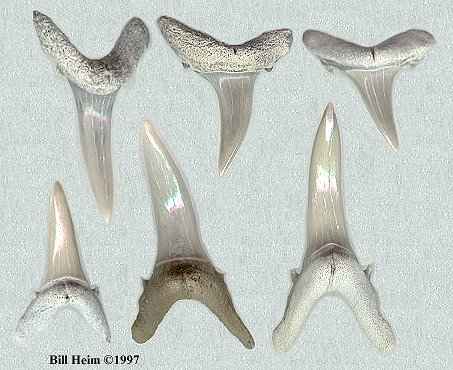Carcharias taurus RAFINESQUE, 1810
aka C. acutissima (AGASSIZ, 1844)
 This species is the extant Sand tiger of today's oceans, and although omitted by some
writers, is the likely candidate for the Yorktown Sand tiger teeth found at Aurora.
Carcharias taurus has been reported from the Miocene/Pliocene. Splitters define it
as being similar to C. acutissima with finer striations and a more robust blade —
characteristics which are not always displayed in dentitions of extant species.
The Lee Creek teeth in Fig. 1 are indistinguishable from the modern species.
This species is the extant Sand tiger of today's oceans, and although omitted by some
writers, is the likely candidate for the Yorktown Sand tiger teeth found at Aurora.
Carcharias taurus has been reported from the Miocene/Pliocene. Splitters define it
as being similar to C. acutissima with finer striations and a more robust blade —
characteristics which are not always displayed in dentitions of extant species.
The Lee Creek teeth in Fig. 1 are indistinguishable from the modern species.
 Figure 1 shows four teeth which conform with the description of C. taurus by
having large, fairly narrow, striated teeth. In the illustration there is an upper anterior,
a 3rd upper anterior (note the tip pointing the "wrong" way), and an upper lateral.
From left to right in the lower jaw, we have a lower lateral, a pathologic lower anterior
(although not very apparent in this image, the blade is badly bent), and another lower
anterior tooth.
Figure 1 shows four teeth which conform with the description of C. taurus by
having large, fairly narrow, striated teeth. In the illustration there is an upper anterior,
a 3rd upper anterior (note the tip pointing the "wrong" way), and an upper lateral.
From left to right in the lower jaw, we have a lower lateral, a pathologic lower anterior
(although not very apparent in this image, the blade is badly bent), and another lower
anterior tooth.
 |
Fig. 1 - aka Carcharias taurus
lingual view of Yorktown specimens,
The largest tooth in this image is 40mm in height. |